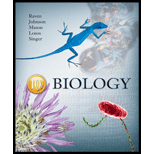
Concept explainers
Humans and pufferfish diverged from a common ancestor about 450 MYA, and these two genomes have
a. very few of the same genes in common.
b. all the same genes.
c. a large proportion of the genes in common.
d. no
Introduction:
Divergent evolution shares common ancestors between two or more species. Such organisms have same structures that are located on different positions in the body as per their need but perform different functions. Such organisms are homologous to each other as they have common homology between them.
Answer to Problem 1U
Correct answer:
Humans and pufferfish diverged from common ancestors about 450 MYA, so they have a large proportion of common genes. Therefore, option c.is correct.
Explanation of Solution
Reason for the correct statement:
Human teeth are evolved from puffer fish, which is later turned into beak in fish. Pufferfish and humans share a common ancestor as they contain a genome known as the fugu genome for over 450 million years ago. This genome is found in fish, but it is also present in humans in the same numbers. However, its size is larger in humans because of the presence of more repetitive DNA in the human genome.
Option c.is given as “a large proportion of gene is common”.
As “pufferfish and humans share common ancestry between them as they have a large proportion of identical genes”, it is the right answer.
Hence, option c.is correct.
Reasons for the incorrect statements:
Option a. is given as “a very few of the same gene in common”.
Pufferfish and human shares common ancestry and human teeth are also evolved from fish. Hence, it is a wrong answer.
Option b.is given as “all the same genes”.
If all the genes are the same between two different species, then there is no such variation that occurs among the individuals among species. Hence, it is a wrong answer.
Option d.is given as “no nucleotide divergence”.
Divergence involves the similarities of amino acids in protein and nucleotide sequence of DNA and RNA between organisms that share a common ancestry. Hence, it is a wrong answer.
Hence, options a., b., and d. are incorrect.
Conclusion:
Human and pufferfish have many identical genes and share common ancestors. However, with time, these genes are rearranged to bring genome revolution, which reveals that the structures might be changed but its function remains the same.
Want to see more full solutions like this?
Chapter 24 Solutions
Biology
- please fill in the empty sports, thank you!arrow_forwardIn one paragraph show how atoms and they're structure are related to the structure of dna and proteins. Talk about what atoms are. what they're made of, why chemical bonding is important to DNA?arrow_forwardWhat are the structure and properties of atoms and chemical bonds (especially how they relate to DNA and proteins).arrow_forward
- The Sentinel Cell: Nature’s Answer to Cancer?arrow_forwardMolecular Biology Question You are working to characterize a novel protein in mice. Analysis shows that high levels of the primary transcript that codes for this protein are found in tissue from the brain, muscle, liver, and pancreas. However, an antibody that recognizes the C-terminal portion of the protein indicates that the protein is present in brain, muscle, and liver, but not in the pancreas. What is the most likely explanation for this result?arrow_forwardMolecular Biology Explain/discuss how “slow stop” and “quick/fast stop” mutants wereused to identify different protein involved in DNA replication in E. coli.arrow_forward
- Molecular Biology Question A gene that codes for a protein was removed from a eukaryotic cell and inserted into a prokaryotic cell. Although the gene was successfully transcribed and translated, it produced a different protein than it produced in the eukaryotic cell. What is the most likely explanation?arrow_forwardMolecular Biology LIST three characteristics of origins of replicationarrow_forwardMolecular Biology Question Please help. Thank you For E coli DNA polymerase III, give the structure and function of the b-clamp sub-complex. Describe how the structure of this sub-complex is important for it’s function.arrow_forward
 Biology (MindTap Course List)BiologyISBN:9781337392938Author:Eldra Solomon, Charles Martin, Diana W. Martin, Linda R. BergPublisher:Cengage Learning
Biology (MindTap Course List)BiologyISBN:9781337392938Author:Eldra Solomon, Charles Martin, Diana W. Martin, Linda R. BergPublisher:Cengage Learning Concepts of BiologyBiologyISBN:9781938168116Author:Samantha Fowler, Rebecca Roush, James WisePublisher:OpenStax College
Concepts of BiologyBiologyISBN:9781938168116Author:Samantha Fowler, Rebecca Roush, James WisePublisher:OpenStax College Human Heredity: Principles and Issues (MindTap Co...BiologyISBN:9781305251052Author:Michael CummingsPublisher:Cengage Learning
Human Heredity: Principles and Issues (MindTap Co...BiologyISBN:9781305251052Author:Michael CummingsPublisher:Cengage Learning Biology: The Dynamic Science (MindTap Course List)BiologyISBN:9781305389892Author:Peter J. Russell, Paul E. Hertz, Beverly McMillanPublisher:Cengage Learning
Biology: The Dynamic Science (MindTap Course List)BiologyISBN:9781305389892Author:Peter J. Russell, Paul E. Hertz, Beverly McMillanPublisher:Cengage Learning
 Human Biology (MindTap Course List)BiologyISBN:9781305112100Author:Cecie Starr, Beverly McMillanPublisher:Cengage Learning
Human Biology (MindTap Course List)BiologyISBN:9781305112100Author:Cecie Starr, Beverly McMillanPublisher:Cengage Learning





